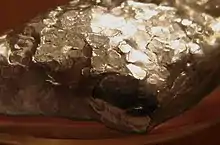
Wood's metal, also known as Lipowitz's alloy or by the commercial names Cerrobend, Bendalloy, Pewtalloy and MCP 158, is a metal alloy that is useful for soldering and making custom metal parts, but its vapor is toxic to touch or breathe. The alloy is named for Barnabas Wood, who invented and patented the alloy in 1860.[1][2] It is a eutectic, fusible alloy of 50% bismuth, 26.7% lead, 13.3% tin, and 10% cadmium by mass. It has a melting point of approximately 70 °C (158 °F).[3][4]
Applications

Other uses include making custom-shaped apertures and blocks (for example, electron-beam cutouts and lung blocks) for medical radiation treatment, and making casts of keys that are hard to otherwise duplicate.[5][6]
Like other fusible alloys, e.g. Rose's metal, Wood's metal can be used as a heat-transfer medium in hot baths. Hot baths with Rose's and Wood's metals are not used routinely but are employed at temperatures above 220 °C (428 °F).[7]
Wood's metal has a modulus of elasticity of 12.7 GPa and a yield strength of 26.2 MPa.[8]
Related alloys
| Alloy | Melting point | Eutectic? | Bismuth % | Lead % | Tin % | Indium % | Cadmium % | Thallium % | Gallium % | Antimony % |
|---|---|---|---|---|---|---|---|---|---|---|
| Rose's metal | 98 °C (208 °F) | no | 50 | 25 | 25 | – | – | – | – | – |
| Cerrosafe | 74 °C (165 °F) | no | 42.5 | 37.7 | 11.3 | – | 8.5 | – | – | – |
| Wood's metal | 70 °C (158 °F) | yes | 50 | 26.7 | 13.3 | – | 10 | – | – | – |
| Field's metal | 62 °C (144 °F) | yes | 32.5 | – | 16.5 | 51 | – | – | – | – |
| Cerrolow 136 | 58 °C (136 °F) | yes | 49 | 18 | 12 | 21 | – | – | – | – |
| Cerrolow 117 | 47.2 °C (117 °F) | yes | 44.7 | 22.6 | 8.3 | 19.1 | 5.3 | – | – | – |
| Bi-Pb-Sn-Cd-In-Tl | 41.5 °C (107 °F) | yes | 40.3 | 22.2 | 10.7 | 17.7 | 8.1 | 1.1 | – | – |
| Gallium | 30.0 °C (86 °F) | Pure metal | - | - | - | - | - | - | 100 | – |
| Galinstan | −19 °C (−2 °F) | no | <1.5 | – | 9.5–10.5 | 21–22 | – | – | 68–69 | <1.5 |
References
- ↑ Jensen, William B. (2010). "The Origin of the Name "Onion's Fusible Alloy"" (PDF). Journal of Chemical Education. 87 (10): 1050–1051. Bibcode:2010JChEd..87.1050J. doi:10.1021/ed100764f. Archived from the original (Archived Reprint) on 2012-04-03.
- ↑ "Collection: Barnabas Wood Papers". SCOUT at University of Tennessee, Knoxville. Retrieved March 22, 2022.
- ↑ G. W. A. Milne, ed. (2005). Gardner's Commercially Important Chemicals: Synonyms, Trade Names, and Properties. John Wiley & Sons. ISBN 978-0-471-73661-5.
- ↑ Khan F. M., Gibbons J. P. "The Physics of Radiation Therapy, 5th ed". Wolters Kluwer.
- ↑ DeviantOllam (2019-05-01), Copying Keys via a Mold and Cast Attack, archived from the original on 2021-12-22, retrieved 2019-05-04
- ↑ The Modern Rogue (2019-10-04), Duplicating a Key Using Molten Metal (with LockPickingLawyer), archived from the original on 2021-12-22, retrieved 2020-11-09
- ↑ Sambamurthy, K. (2007). Pharmaceutical Engineering. New Age International. ISBN 9788122411690.
- ↑ Do-Gyoon, Kim (February 2006). "Evaluation of Filler Materials Used for Uniform Load Distribution at Boundaries During Structural Biomechanical Testing of Whole Vertebrae". Journal of Biomechanical Engineering. 128 (1): 161–165. CiteSeerX 10.1.1.721.5864. doi:10.1115/1.2133770. PMID 16532630.
Bibliography
- Birchon's Dictionary of Metallurgy, London, 1965
- Experimental techniques in low-temperature physics, G. K. White, Oxford University Press, Third Edition
External links
- Making your own low-melting point eutectic: Science Toys: A metal that melts in hot water
- Burdakin et al., "Melting points of gallium and of binary eutectics with gallium", Metrologia, 2008
 Media related to Wood's metal at Wikimedia Commons
Media related to Wood's metal at Wikimedia Commons